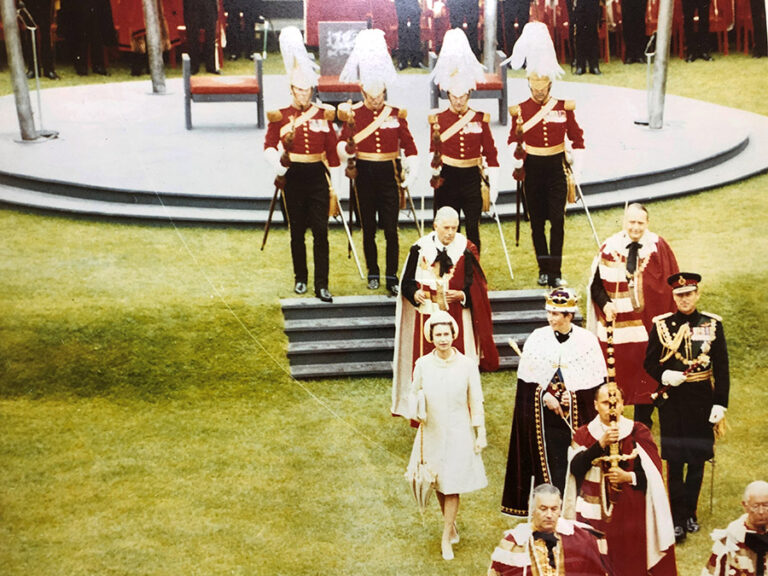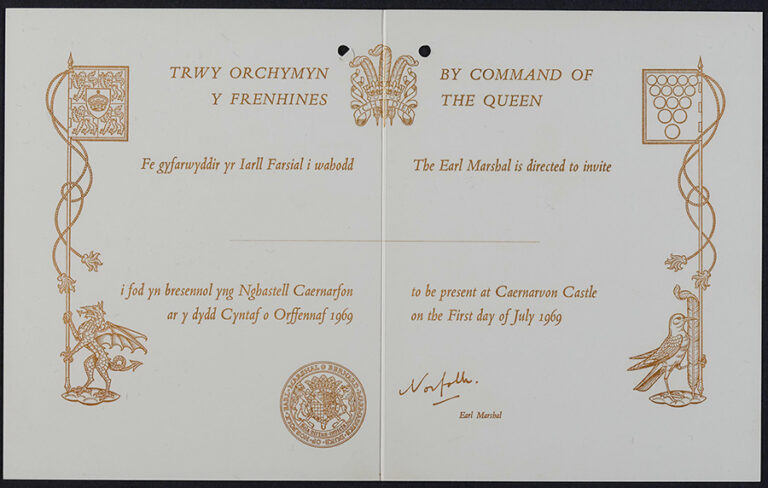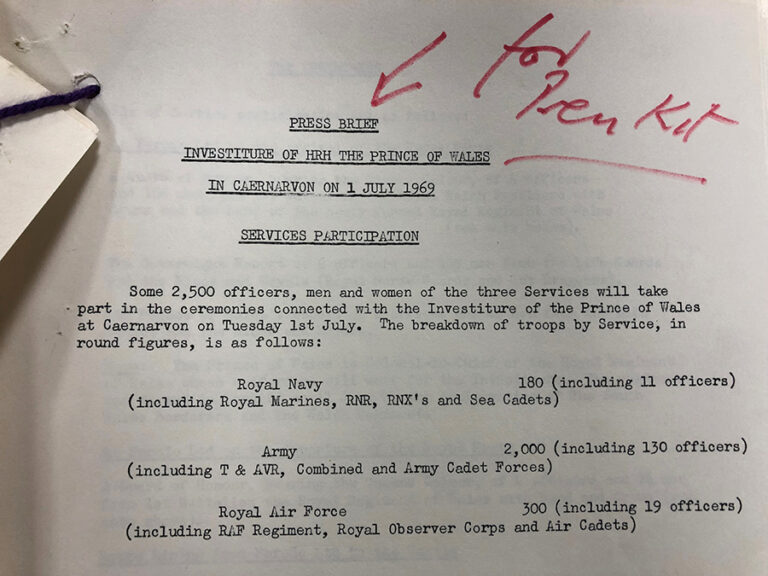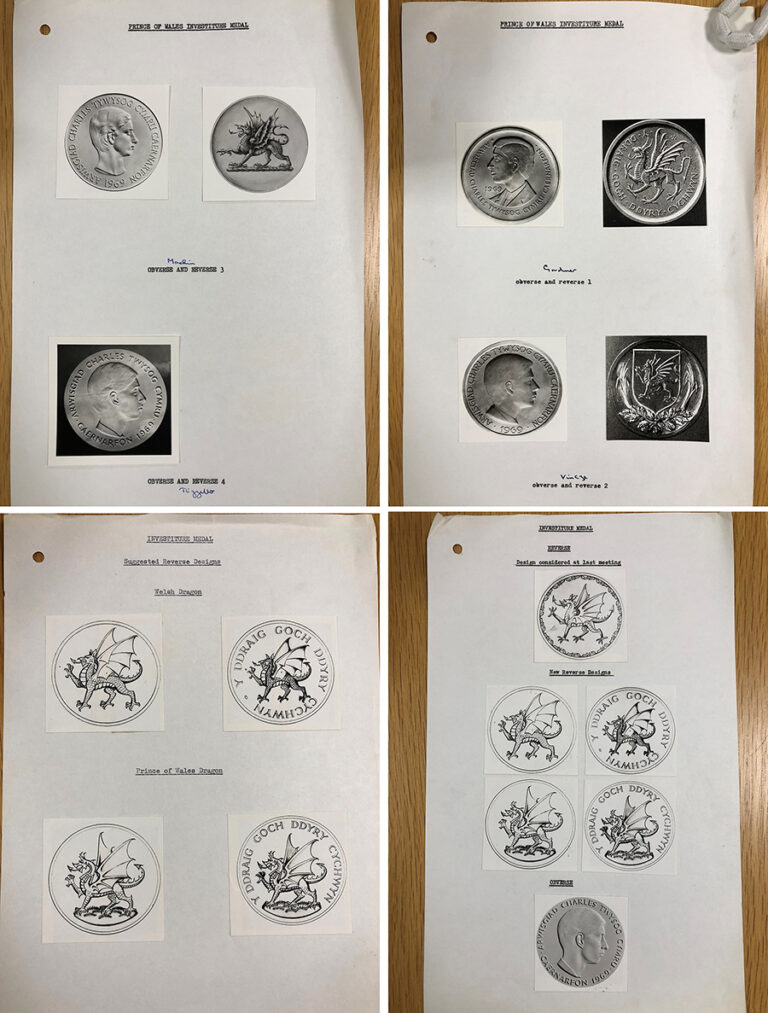In anticipation for the Investiture of the Prince of Wales, a booklet produced by the Welsh Tourist Board in 1969 declared:
In this little country of 2½ million people, on 1st July, 1969, His Royal Highness Prince Charles will be invested with the insignia of the office of the Prince of Wales – just four months before his 21st birthday. He is the twentieth Prince to hold the title.
Bulletin, no.1, Wales Tourist Board, BD/54, The National Archives
On 1 July 1969, Queen Elizabeth II invested her eldest son, Prince Charles, as the Prince of Wales. The investiture took place at Caernarfon Castle in Wales.
The National Archives’ ‘Royalty on Record’ programme, which celebrates the Queen’s Platinum Jubilee, offers us a chance to look back at past royal occasions, such as Prince Charles’ investiture. This blog post draws upon the records of the Welsh Office, the Royal Mint, the Ministry of Public Building and Works, and the Air Ministry to revisit this moment in history.

Traditionally, the Sovereign’s eldest son is bestowed the Prince of Wales title. A letter to the Prime Minister Harold Macmillan, dated 29 June 1958, shows that the Queen planned to announce Prince Charles’ title as the Prince of Wales at the closing ceremony of the Commonwealth Games in Cardiff (see footnote 1). Prince Charles was later made the Prince of Wales and Earl of Chester on 26 July 1958 at the age of nine, but it was agreed that the investiture would not take place until Prince Charles was older.
Prior to the investiture, Prince Charles spent a term studying at University College of Wales in Aberystwyth, where he learnt about Welsh history, culture and language. During the ceremony, Prince Charles gave his address in Welsh, and his replies in both Welsh and English. In an interview after the investiture, Prince Charles said ‘for me, it’s a way of officially dedicating one’s life or part of one’s life to Wales’ (footnote 2).
The investiture took place at a time of rapid social change during the 1960s, and a growing Welsh nationalist movement. Nonetheless, the investiture was largely welcomed by people in Wales.
An Investiture Committee, under the Chairmanship of the Earl Marshall, was established to organise the investiture. The Earl Marshall proposed:
minor departures from tradition, intended mainly to facilitate the television presentation of the Investiture, for example, by asking the Prince of Wales to take his place near the front of his procession from the Chamberlain Tower to the dais rather behind the traditional body of peers bearing regalia.
Minutes of the fourth meeting of the Investiture Committee, 13 February 1969, AIR 2/18374, The National Archives
The investiture was televised by the BBC in both colour and in black and white. It was watched by 19 million people in Britain, and 500 million around the world! (footnote 3)
Around 4,000 guests were invited to the investiture, 3,500 of which were people who lived and worked in Wales (footnote 4). Below is an invitation to the investiture which is written in both Welsh and English. Documents and publications concerning the investiture were printed in both languages.

During the ceremony, Prince Charles had the coronet and robes placed on him, and he subsequently pledged his allegiance to The Queen with the words: ‘I, Charles, Prince of Wales, do become your liege man of life and limb and of earthly worship, and faith and truth I will bear unto thee, to live and die against all manner of folks.’ (footnote 5)
This press brief stated that 2,500 officers serving across the three Armed Forces (Royal Navy, Army and Royal Air Force) would take part in the ceremony.

It goes on to declare that:
The Prince of Wales is Colonel-in-Chief of the Royal Regiment of Wales whose uniform he will wear for the Investiture. The regiment was formed in Cardiff on 11 June by the amalgamation of The South Wales Boarders and The Welsh Regiment.
Press brief, BD 67/86, The National Archives
There was also a Royal Air Force flypast which saw 24 aircrafts fly over Caernarfon Castle (footnote 6).
After the Investiture, the Prince of Wales began a four-day tour around Wales. The press brief noted that Prince Charles ‘wishes to meet as many people as possible, that informality should be the keynote and formal occasions kept to a minimum’ (footnote 7).
To commemorate the Investiture of the Prince of Wales, a souvenir medal was produced by the Royal Mint. A number of artists were invited to compete in a competition to design the official souvenir medal. Royal Mint records show numerous designs for the medal. The designs were then considered by the Royal Mint Advisory Committee and Michael Rizzello’s designs were selected (footnote 8).

As you can see from the designs, the profile of Prince Charles is on the obverse, with the surrounding inscription ‘ARWISGIAD CHARLES TYWYSOG CYMRU CAERNARFON 1969’, the Welsh for ‘Investiture of Charles, Prince of Wales.’ The reverse of the medal shows the Welsh dragon.
The records held at The National Archives provide us with a fascinating insight into the investiture of the Prince of Wales. As the jubilee weekend approaches, keep an eye out on our blog and social media for more ‘Royalty on Record’ content.
Footnotes
- Letter to the Prime Minister, 29 June 1958, BD 67/2, The National Archives.
- Marisa R Cull, ‘Prince Charles, George Peel, and the Theatrics of Monarchical Ceremony’, Oxford University Press Blog, (accessed 18 May 2022)
- ‘Investiture of the Prince of Wales’, BBC, (accessed 16 May 2022).
- ‘The Investiture of HRH The Prince of Wales at Caernarfon Castle, 1st July 1969’, Royal Collection Trust, (accessed 18 May 2022).
- Press brief, BD 67/86, The National Archives.
- Press brief, BD 67/86, The National Archives.
- Press notice, 13 February 1969, AIR 2/18374, The National Archives.
- Letter to B M Bayliss from B W Tucker, 23 September 1968, MINT 20/4236, The National Archives.

Is there a public list of those who were invited please?
Were the general public allowed to watch from the battlements of Caernarfon Castle?
My mother and father were at the Investiture. My dad was Director at Firestone International which was one of the largest employers in Wales at the time. Their presence was commanded by the Queen. My parents kept all the papers and were able to also buy their chairs.